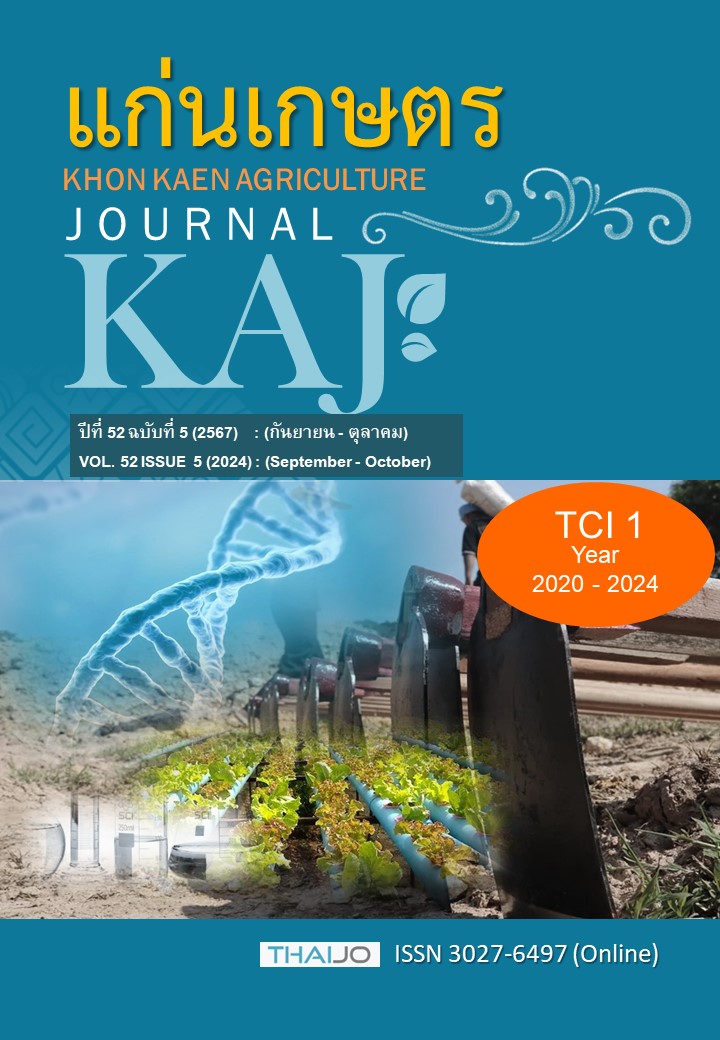ผลของส่วนของท่อนพันธุ์ที่ต่างกันต่อการงอก การเจริญเติบโต พัฒนาการ และผลผลิตของมันสำปะหลัง 2 พันธุ์ภายใต้การปลูกด้วยท่อนพันธุ์ขนาดเล็ก
Main Article Content
บทคัดย่อ
องค์ความรู้เกี่ยวกับเทคนิคการขยายพันธุ์มันสำปะหลังแบบเร่งรัดนับเป็นแนวทางสำคัญในการเพิ่มการผลิตท่อนพันธุ์ปลอดโรคใบด่างมันสำปะหลัง ให้เพียงพอต่อความต้องการของเกษตรกรภายใต้สถานการณ์การระบาดของโรค งานวิจัยนี้มีวัตถุประสงค์เพื่อศึกษาอิทธิพลของส่วนของท่อนพันธุ์ขนาดเล็กต่อเปอร์เซ็นต์การงอก ความแข็งแรงของต้นกล้า การเจริญเติบโต พัฒนาการ และผลผลิตของมันสำปะหลัง 2 พันธุ์ที่มีรูปแบบการแตกกิ่งที่ต่างกัน ใช้แผนการศึกษา 2 x 2 Factorial in completely randomized design จำนวน 4 ซ้ำ โดยกำหนดให้ปัจจัย A เป็นมันสำปะหลัง 2 พันธุ์ (พันธุ์ระยอง 9 และสายพันธุ์ CMR38-125-77) และปัจจัย B เป็นตำแหน่งท่อนพันธุ์ที่ต่างกัน (ตัดจากส่วนบน และส่วนกลางของต้นพันธุ์มันสำปะหลัง) ทำการปลูกทดสอบในถาดหลุมภายใต้สภาพเรือน และในกระถางดินภายใต้สภาพธรรมชาติ ผลการศึกษาพบว่ามันสำปะหลังสายพันธุ์ CMR38-125-77 มีเปอร์เซ็นต์การงอก ความเร็วในการงอก ดัชนีความแข็งแรง ความสูงต้นกล้า น้ำหนักแห้งต้นกล้า พัฒนาการความสูงต้น จำนวนใบ และความสูงทรงพุ่มช่วง 1-4 เดือนหลังย้ายปลูกที่สูงกว่ามันสำปะหลังพันธุ์ระยอง 9 ขณะที่ท่อนพันธุ์ส่วนกลางของทั้ง 2 พันธุ์มีเปอร์เซ็นต์การงอก ดัชนีความแข็งแรง ความเร็วในการงอก ความยาวราก พื้นที่ใบ น้ำหนักแห้งส่วนเหนือดิน น้ำหนักแห้งหัว และมวลชีวภาพที่อายุ 6 เดือน สูงกว่าท่อนพันธุ์ที่ปลูกจากส่วนบนของลำต้น อย่างไรก็ตามมันสำปะหลังพันธุ์ที่ต่างกันไม่ส่งผลต่อความแตกต่างทางสถิติของน้ำหนักแห้งหัวที่อายุ 6 เดือน นอกจากนี้ยังพบว่ามันสำปะหลังสายพันธุ์ CMR38-125-77 ที่ปลูกจากส่วนกลางของลำต้นมีดัชนีเก็บเกี่ยวสูงที่สุด
Article Details

อนุญาตภายใต้เงื่อนไข Creative Commons Attribution-NonCommercial-NoDerivatives 4.0 International License.
เอกสารอ้างอิง
มูลนิธิสถาบันพัฒนามันสำปะหลังแห่งประเทศไทย. 2566. พันธุ์ต้านทานมันสำปะหลังชุดแรกของประเทศไทย. บริษัทเท็กซ์ แอนด์ เจอร์นัล พับลิเคชั่น จำกัด. กรุงเทพฯ.
สถาบันวิจัยและพัฒนาแห่งมหาลัยเกษตรศาสตร์. 2558. การใช้ประโยชน์ผลิตภัณฑ์จากมันสำปะหลัง. แหล่งข้อมูล: https://www3.rdi.ku.ac.th/?p=17866. ค้นเมื่อ 14 กรกฎาคม 2565.
สำนักงานเศรษฐกิจการเกษตร. 2563. เนื้อที่เพาะปลูก จำนวนครัวเรือน และเนื้อที่เพาะปลูกเฉลี่ยต่อครัวเรื่อนระดับจังหวัดปี 2563. แหล่งข้อมูล: https://www.oae.go.th/assets/portals/1//prcaidata/files/Casava%20Holdland%2063.pdf. ค้นเมื่อ 4 มกราคม 2565.
สำนักส่งเสริมการค้าสินค้าเกษตรและอุตสาหกรรม. 2564. ผลิตภัณฑ์มันสำปะหลัง. แหล่งข้อมูล: https://ditp.go.th. ค้นเมื่อ 14 กรกฎาคม 2565.
โอภาษ บุญเส็ง. 2563. มันสำปะหลังไทย ชีววิทยา การผลิต และการแปรรูป. ไม่ปรากฏสถานที่พิมพ์.
Abdul-Baki, A. A., and J. D. Anderson. 1973. Vigor determination in soybean seed by multiple criteria. Crop Science. 13(6): 630-633.
Amarullah, I. D., P. Yudono, and B. D. Sunarminto. 2016. Effect of source sink manipulation on yield and related yield components in cassava, Manihot esculenta Crantz. International Journal of Agricultural Research, Innovation and Technology. 6(2): 69-76.
Bona, C. M., I. R., Biasetto, M. Masetto, C. Deschamps, and L. A. Biasi. 2012. Influence of cutting type and size on rooting of Lavandula dentata L. Revista Brasileira de Plantas Medicinais. 14: 8-11.
Burns, A., R. Gleadow, J. Cliff, A. Zacarias, and T. Cavagnaro. 2010. Cassava: the drought, war and famine crop in a changing world. Sustainability. 2(11): 3572-3607.
Czabator, F. J. 1962. Germination value: an index combining speed and completeness of pine seed germination. Forest Science. 8(4): 386-396.
El‐Sharkawy, M. A., S. M. De Tafur, and L. F. Cadavid. 1992. Potential photosynthesis of cassava as affected by growth conditions. Crop Science. 32(6): 1336-1342.
El-Sharkawy. 2014. Global warming: causes and impacts on agroecosystems productivity and food security with emphasis on cassava comparative advantage in the tropics/subtropics. Photosynthetica. 52(2): 161-178.
Fogaça, C. M., B. F. Sant'Anna-Santos, D. C. Cordeiro, T. D. Correia, F. L. Finger, W. C. Otoni, and A. Cargnin. 2010. In vitro microtuberization of cassava cultivars: morphological and anatomical aspects. Acta Botanica Brasilica. 24: 624-630.
Hartmann, H. T., D. E. Kester Davies, F. T. Junior, and R. L. Geneve. 2011. Plant propagation: principles and practices, 8th edition, Englewood Clipps. 915 p.
Hartati, T. M., C. Roini, and I. Rodianawati. 2021. Growth response of local cassava to cutting models and the number of buds. Caraka Tani: Journal of Sustainable Agriculture. 36(2): 379-391.
Hidayat, R. 2004. Study of assimilate translocation patterns at different plant ages of mangosteen (Garcinia Mangostana L.). Jurnal Agrosains. 6(1): 20-25.
Janket, A., N. Vorasoot, B. Toomsan, W. Kaewpradit, P. Theerakulpisut, C. C. Holbrook, C. K. Kvien, S. Jogloy, and P. Banterng. 2021. Quantitative evaluation of macro-nutrient uptake by cassava in a tropical savanna climate. Agriculture. 11(12): 1199.
Mohankumar, C.R. 1988. Planting material production and nursery practices in cassava. In Production and Utilization of Cassava in India. pp. 61-67.
Neves, R. J., R. P. Diniz, and E. J. Oliveira. 2018. Productive potential of cassava plants (Manihot esculenta Crantz) propagated by leaf buds. Anais da Academia Brasileira de Ciências. 90: 1733-1747.
Neves, R. J., L. S. Souza, and E. J. Oliveira. 2019. A leaf bud technique for rapid propagation of cassava (Manihot esculenta Crantz). Scientia Agricola. 77: e20180005.
NurulNahar, E., and S.L. Tan. 2012. Cassava mini-cuttings as a source of planting material. Journal of Tropical Agriculture and Food Science. 40(1): 145-151.
Office of Agricultural Economics. 2020. Situation analysis of cassava mosaic disease. Available: https://www.nabc.go.th/disaster/baidang. Accessed Oct. 12, 2020.
Phoncharoen, P., P. Banterng, N. Vorasoot, S. Jogloy, P. Theerakulpisut, and G. Hoogenboom. 2019a. Growth rates and yields of cassava at different planting dates in a tropical savanna climate. Scientia Agricola. 76: 376-388.
Phoncharoen, P., P. Banterng, N. Vorasoot, S. Jogloy, P. Theerakulpisut, and G. Hoogenboom. 2019b. The impact of seasonal environments in a tropical savanna climate on forking, leaf area index, and biomass of cassava genotypes. Agronomy. 9(1): 19.
Rüscher, D., J. M. Corral, A. V. Carluccio, P. A. Klemens, A. Gisel, L. Stavolone, H. E. Neuhaus, F. Ludewig, E. Sonnewald, and W. Zierer. 2021. Auxin signaling and vascular cambium formation enable storage metabolism in cassava tuberous roots. Journal of Experimental Botany. 72(10): 3688-3703.
Santanoo, S., K. Vongcharoen, P. Banterng, N. Vorasoot, S. Jogloy, S. Roytrakul, and P. Theerakulpisut. 2019. Seasonal variation in diurnal photosynthesis and chlorophyll fluorescence of four genotypes of cassava (Manihot esculenta Crantz) under irrigation conditions in a tropical savanna climate. Agronomy. 9(4): 206.
Statistix. 2013. version 10; Analytical Software: Tallahassee, FL, USA.
Tokunaga, H, B. Tamon, I. Manabu, I. Kasumi, K. Ok-Kyung, H.H. Le, K.L. Hoang, M. Kensaku, T.N. Keiko, V.D. Nguyen, N.H. Huu, C.N. Nien, A.V. Nguyen, N. Hisako, S. Motoaki, S. Pao, T. Hirotaka, T. Bunna, X.T. Hoat, U. Masashi, U. Ayaka, U. Yoshinori, W. Prapit and T. Keiji. 2018. Sustainable management of invasive cassava pests in Vietnam, Cambodia, and Thailand. In: Kokubun M and S. Asanuma (Eds.). Crop production under stressful conditions. Singapore: Springer, p. 131–157.
Tokunaga, H., N. H. Anh, N. V. Dong, L. H. Ham, N. T. Hanh, N. Hung, and M. Seki. 2020. An efficient method of propagating cassava plants using aeroponic culture. Journal of Crop Improvement. 34(1): 64-83.
Yomeni M., M. A. Akoroda, and Dixon 2012. Cassava (Manihot esculenta Crantz) stems quality for root production effectiveness. In: Proceedings of the 11th triennial Symposium of the ISTRC-AB held at Memling Hotel: Tropical roots and tuber crops and the challenges of globalization and climate changes, p. 261-269.


